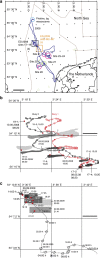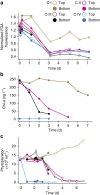Immediate ecotoxicological effects of short-lived oil spills on marine biota
- PMID: 27041738
- PMCID: PMC4822028
- DOI: 10.1038/ncomms11206
Immediate ecotoxicological effects of short-lived oil spills on marine biota
Abstract
Marine environments are frequently exposed to oil spills as a result of transportation, oil drilling or fuel usage. Whereas large oil spills and their effects have been widely documented, more common and recurrent small spills typically escape attention. To fill this important gap in the assessment of oil-spill effects, we performed two independent supervised full sea releases of 5 m(3) of crude oil, complemented by on-board mesocosm studies and sampling of accidentally encountered slicks. Using rapid on-board biological assays, we detect high bioavailability and toxicity of dissolved and dispersed oil within 24 h after the spills, occurring fairly deep (8 m) below the slicks. Selective decline of marine plankton is observed, equally relevant for early stages of larger spills. Our results demonstrate that, contrary to common thinking, even small spills have immediate adverse biological effects and their recurrent nature is likely to affect marine ecosystem functioning.
Figures




References
-
- Kemsley J. Reckoning with oil spills. Chem. Eng. News 93, 8–12 (2015) .
-
- Joye S. B. Deepwater Horizon, 5 years on. Science 349, 592–593 (2015) . - PubMed
-
- The International Tanker Owners Pollution Federation Ltd. Oil tanker spill statistics 2014. Available at www.itopf.com/.../data/.../Oil_Spill_Stats_2014FINALlowres.pdfITOPF, London, UK (2015) .
Publication types
MeSH terms
Substances
LinkOut - more resources
Full Text Sources
Other Literature Sources
Medical
Miscellaneous

